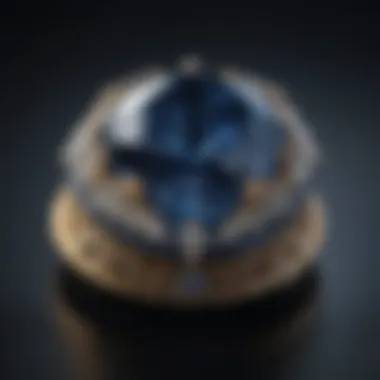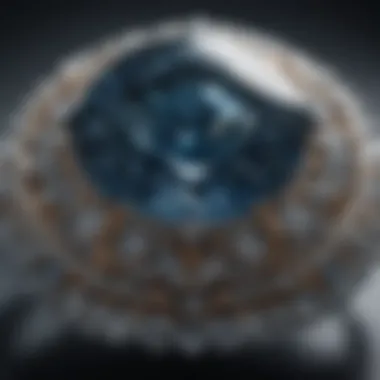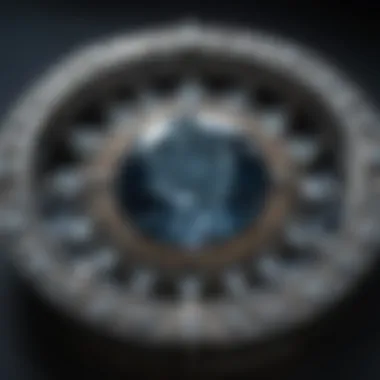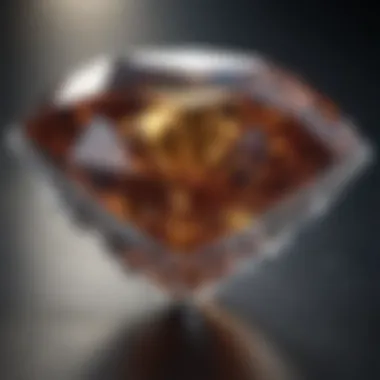Is the Hope Diamond the Largest Gemstone Ever?


Intro
Exploring the history, size, and unique aspects of the Hope Diamond arrises significant curiosity among gemstone enthusiasts. This article aims to dissect the dimensions of the Hope Diamond in relation not just to its personal lore, but also its stature in the global hierarchy of diamonds.
The journey into the realm of gemstones elucidates more than mere numbers. It unveils narratives rich with culture, trade, and mythology. The question of whether the Hope Diamond claims the title of the biggest diamond in the world opens a conversation about clarity, weight, and historical relevance.
Through evaluating these dimensions, we will ultimately analyze the implications this diamond holds within the gemstone industry.
Gemstone Overview
Description of the gemstone
The Hope Diamond is a captivating blue gemstone with a storied past. Weighing approximately 45.52 carats, it is renowned not just for its impressive size but also for its remarkable color and clarity. The diamond exhibits a unique deep blue hue caused by the presence of boron, giving it an unmistakable appearance among diamonds.
Physical properties
In terms of physical properties, the Hope Diamond is classified as a Type IIb diamond. This classification indicates its relative lack of nitrogen impurities, which contributes to its color saturation. Here are some core characteristics of the Hope Diamond:
- Weight: 45.52 carats
- Color: Fancy Deep Blue
- Clarity: VS1 (Very Slightly Included)
- Cut: Cushion cut
- Dimensions: Approximately 25 mm x 21 mm x 12 mm
The diamond’s remarkable optical properties enhance its allure. It refracts light and exhibits a brilliance that captivates the beholder, cementing its position as one of the most significant gemstones in history.
"The Hope Diamond's storied history intertwines with the myths and legends that surround it."
Understanding the Hope Diamond's historical significance compels further examination of how it fits into the world of gems at large. Is it the biggest or merely one among many? As we proceed, we will analyze its standing among other diamonds to uncover the truth behind this question.
Preface to the Hope Diamond
The Hope Diamond is one of the most renowned gemstones in the world. Its notoriety stems not only from its striking beauty but also from its complex history and unique characteristics. Understanding the Hope Diamond is essential to grasp its significance within the gemstone domain and the broader cultural context. This section delves into the Hope Diamond’s historical background and cultural significance, providing readers with foundational knowledge that enhances the discussion of its size and importance.
Historical Background of the Hope Diamond
The Hope Diamond's history is rich and tumultuous. The diamond originated from the Golconda mines in India, where it was originally known as the Tavernier Blue. It is believed to have been mined in the 17th century, and French gem merchant Jean-Baptiste Tavernier introduced it to Europe. The diamond gained its famous blue hue from the presence of boron within its crystal structure. Over the years, it passed through various hands, often incurring a trail of misfortune and mystery. Its transformation into the Hope Diamond happened when it was purchased by King Louis XIV of France in 1668, who had it recut into a heart shape. After it was stolen during the French Revolution, it resurfaced in London, re-emerging in the hands of various owners, leading to its current location at the Smithsonian Institution.
Cultural Significance of the Hope Diamond
The cultural significance of the Hope Diamond cannot be overstated. It is not just a jewel; it embodies a narrative of luxury, loss, and legend. Folklore associated with the Hope Diamond includes tales of curses and tragedy, which have propelled its mystique over centuries. This has made the diamond a subject of numerous studies, films, and literature. Furthermore, it serves as a symbol of wealth and power that transcends geographical boundaries.
"The Hope Diamond is not merely a stone; it is a cultural artifact that holds stories that resonate across generations."
Gemstone enthusiasts and collectors often regard it as a must-see piece, and its display at the Smithsonian has made it easily accessible to the public. This diamond, with its captivating color and lore, represents a continuous intersection between natural beauty and human history. Understanding the Hope Diamond's cultural significance contributes to a deeper appreciation when considering its size in comparison to other notable diamonds.
Characteristics of Diamonds
Understanding the characteristics of diamonds is essential for anyone interested in gemstones. Diamonds are not just beautiful; they are complex formations that hold significant value in both monetary and cultural terms. This section will dive into the specific elements that define a diamond's quality and stature, focusing particularly on the Hope Diamond. Recognizing how carat weight, clarity, color, and cut contribute to a gemstone's overall appeal is key to understanding its place within the broader context of precious stones.


Understanding Carat Weight
Carat weight is perhaps the most recognized characteristic of diamonds. One carat is equivalent to 200 milligrams, and this measurement plays a crucial role in determining a diamond's price. A diamond's carat weight directly correlates to its size, which is often a critical factor for buyers.
However, carat weight alone does not define value. For example, two diamonds of equal carat weight can differ significantly in price based on their clarity, color, and cut. When assessing the Hope Diamond, its substantial weight of 45.52 carats draws attention. This makes it one of the largest blue diamonds known; however, it is not merely the size that adds to its allure. The story, mystique, and historical context also play significant roles in its valuation.
Clarity and Color Explained
Clarity refers to the presence of internal or external imperfections, known as inclusions and blemishes. These flaws can affect a diamond's brilliance and overall beauty. A diamond with fewer imperfections is generally more valuable. The Hope Diamond, for instance, has a clarity grade of VS1, indicating that it has very slight inclusions visible under 10x magnification. This grade allows the stone to exhibit its stunning visual appeal without significant distractions.
Color grading in diamonds signifies the absence of color. The scale typically ranges from D (colorless) to Z (light yellow). The Hope Diamond is a fancy blue diamond, showcasing a specific hue attributed to the presence of boron. This unique quality enhances its desirability, yet color contributes a complex layer to a diamond's classification. In combination with clarity, the color of a diamond can dramatically influence both its market value and its aesthetic characteristics.
Cut and Its Impact on Appearance
The cut of a diamond refers to how well it has been shaped and faceted. It greatly affects the stone’s brilliance and how it reflects light. A poorly cut diamond can appear dull, regardless of its carat weight or clarity. For the Hope Diamond, the cushion cut is employed, allowing it to exhibit a combination of depth and radiance that is captivating to the eye.
The quality of cut is graded on a scale from Excellent to Poor, measuring factors such as proportions, symmetry, and polish. The cut quality enhances the diamond's ability to transmit light, creating that sought-after sparkle. Therefore, when discussing the Hope Diamond, understanding how the cut interacts with light and enhances its intrinsic qualities is vital.
In summary, characteristics of diamonds such as carat weight, clarity, color, and cut significantly influence the identity and perceived value of a diamond. Knowing these factors not only assists collectors and enthusiasts in making informed decisions but also deepens appreciation for gems like the Hope Diamond.
Measuring the Hope Diamond
Understanding the dimensions of the Hope Diamond is essential in appreciating its beauty and significance in the world of gemstones. Measuring not only includes the carat weight but also the physical dimensions and shape of the diamond. Together, these factors contribute to its overall aesthetic and market value. A detailed examination helps clarify whether the Hope Diamond can rightly claim the title of being the largest diamond.
Carat Weight of the Hope Diamond
The Hope Diamond weighs 45.52 carats. This weight places it among the notable diamonds in the world, yet it does not surpass other larger diamonds, such as the Cullinan Diamond. However, the Hope Diamond's unique color and history add to its allure and value, making it stand out despite its size.
"The weight of a diamond is not the only characteristic that determines its significance; it is the combination of history, beauty, and market demand that enhances its value."
Carat weight is a primary factor considered by collectors and buyers. Each carat corresponds to a specific weight, with one carat equal to 200 milligrams. Larger diamonds are often rarer, leading to higher market prices. Therefore, when discussing the Hope Diamond, it is necessary to examine how its weight affects its desirability.
Dimensions and Shape
The dimensions of the Hope Diamond are approximately 25.61 mm in length, 21.78 mm in width, and 12.00 mm in depth. Its cushion cut shape contributes to its brilliant appearance and allows for light to reflect beautifully through its facets. This sophisticated cut is favored by many due to its ability to enhance color and shine.
The diamond's deep blue hue originates from the presence of boron within its crystal structure. This distinct color is a significant aspect of its identity. The combination of size, shape, and color plays a crucial role in defining the diamond's place among the world's most remarkable gemstones.
In summary, measuring the Hope Diamond involves much more than just its carat weight. Both its dimensions and shape significantly impact its overall impression, setting it apart in the diamond world. Understanding these factors aids enthusiasts and collectors in appreciating this gemstone's true allure.
Comparison with Other Famous Diamonds
The discussion surrounding the Hope Diamond’s size cannot be complete without comparing it to other famous diamonds. Each of these gems holds its own historical and cultural significance, making the comparison essential to understanding the place of the Hope Diamond within the gemstone world. By examining these diamonds, we can appreciate the unique qualities of each, including size, clarity, and the storied history that often accompanies them.
When evaluating the Hope Diamond against its counterparts, it allows us to determine not just if it is the biggest, but how it stands apart in terms of lore, mystique, and desirability. The insights drawn from this comparative analysis illuminate the characteristics that define a diamond’s reputation.
The Cullinan Diamond


The Cullinan Diamond is renowned as one of the largest diamonds ever discovered, originally weighing in at 3,106 carats. Its discovery in South Africa in 1905 led to its cutting into several notable stones, most famously the Great Star of Africa and the Lesser Star of Africa. This diamond's connection to British royalty, as the centerpiece of Britain's Crown Jewels, solidifies its status in history. Unlike the Hope Diamond, which is well-known for its deep blue color and supposed curse, the Cullinan exemplifies the traditional qualities of diamonds appreciated for their size and brilliance. Moreover, the sheer scale of the Cullinan Diamond effectively positions it above the Hope Diamond in terms of raw carat weight.
The Blue Moon Diamond
The Blue Moon Diamond, a 12 carat fancy vivid blue diamond, is more contemporary than both the Hope and Cullinan Diamonds. It gained significant public attention after being sold at auction for over $48 million in 2015. This diamond’s unique color and remarkable clarity contribute to its high value, much like the Hope Diamond’s distinct hue. What sets it apart is its modern pedigree and the way it has reshaped the marketplace for colored diamonds. In a direct comparison, while the size of the Hope Diamond is notable, it lacks the same level of financial transaction impact that the Blue Moon has achieved recently. This comparison highlights the evolving dynamics in the diamond market and changing perceptions of value over time.
The Imperial Green Jadeite
The Imperial Green Jadeite, although not a diamond, presents an interesting comparison. Often revered for its deep green color, it represents a different tier within the gemstone community. The Jadeite's value can surpass that of many high-carat diamonds due to its rarity and cultural significance in Chinese traditions. This diamond-like material challenges the notion that only diamonds command such a high stature in gemstone valuation. The Hope Diamond, valued not only for its size but also for its rich history and alleged curse, holds a different but equally compelling narrative when placed next to the Imperial Green Jadeite. Thus, this comparison broadens the scope of what we consider when viewing gemstones and their relative importance in historical and cultural contexts.
Diamonds in Historical Context
Understanding the historical context of diamonds provides important insight into their significance beyond mere aesthetics. Throughout history, diamonds have symbolized wealth, power, and social status. They have often been used as tokens of love and commitment, seen in engagement rings and other pieces of jewelry. In various cultures, diamonds have held different meanings, often intertwined with myths and legends that increased their allure.
The importance of diamonds in historical texts also paints a vivid picture of their journey in society. The Hope Diamond, specifically, stands out not only for its physical attributes but also for its intriguing history. The tale of its ownership has included royals, thieves, and collectors, all contributing to its mystique. Acknowledging this context enhances our understanding of why the Hope Diamond is celebrated and feared in equal measure. The symbolism associated with diamonds often permeates both societal and personal narratives, embedding them deeply in human culture.
Notable Diamond Heists
Diamonds have often drawn the attention of criminals. History is rife with notable diamond heists that demonstrate the lengths to which individuals go for these precious stones. One of the most infamous heists occurred in 1911 at the Imperial Museum in London, where a gang managed to steal over 300 pieces of jewelry, including a diamond worth thousands today.
Such heists not only highlight the value placed on diamonds but also add to the lore surrounding these gemstones. The theft of notable diamonds often leads to questions regarding their previous owners and their significance, consequently adding layers to their story. The Hope Diamond was rumored to be cursed, which only intensified the allure surrounding it. The narrative of its theft and eventual recovery continues to cement its place in history.
Cultural Representations of Diamonds
Diamonds have a significant presence in various forms of art and cultural narratives. From Shakespeare's writings to modern-day cinema, diamonds are often depicted as symbols of unattainable desires or ultimate luxury. Films frequently utilize diamonds as plot devices, emphasizing their association with greed, betrayal, or romance.
In addition, diamonds have been used as metaphors in literature and art to explore themes of beauty, timelessness, and human aspiration. For instance, the recurring themes of diamonds in poems reflect a societal perception of diamonds as more than just physical entities; they embody the ideals people strive for.
"Diamonds are a girl’s best friend" is a phrase that has persisted, underscoring the deep-rooted cultural connection many have with these gems. This cultural significance further elevates the Hope Diamond, as it has become a touchstone for discussions about love, commitment, and even mystery.
Both notable heists and cultural representations intertwine in fascinating ways, enhancing the narrative of diamonds through history. Diamonds resonate on multiple levels, captivating and inspiring generations while making a lasting impact in society.
Scientific Analysis of the Hope Diamond
Understanding the scientific analysis of the Hope Diamond is essential for appreciating its unique characteristics and significance in the diamond world. This examination encompasses the diamond's gemological properties and its geological origins. By employing stringent scientific methods, experts uncover factors that contribute to the diamond's allure, like its clarity, color, and molecular structure.
Gemological Properties
The gemological properties of the Hope Diamond comprise its carat weight, color, clarity, and cut.
- Carat Weight: The Hope Diamond weighs an impressive 45.52 carats, placing it among the larger diamonds known. However, while size is notable, it is the interplay of all properties that influences its value and prestige.
- Color: Classified as a fancy dark grayish-blue diamond, it exhibits a captivating hue due to the presence of boron. This elemental fusion not only enhances its visual appeal but also connects it uniquely to its geological formation.
- Clarity: The clarity grade of the Hope Diamond is not without its imperfections, but these inclusions are often part of its character. Each blemish tells a story of the diamond's journey through time and nature.
- Cut: The cushion cut of the Hope Diamond is a factor that affects how light interacts with it. This shape allows for the maximum reflection of light, creating a brilliant sparkle that captivates the eye.
By examining these elements, we gain greater insight into what defines the Hope Diamond's reputation as an exceptional gemstone despite not being the largest.
Origin and Formation of the Hope Diamond


The origin of the Hope Diamond presents an intriguing narrative that spans continents and millennia. The diamond is believed to have originated from the Golconda mines located in India, which are historically acclaimed for producing the world’s most remarkable diamonds. The geological processes, millions of years old, led to the formation of this precious stone deep within the Earth’s crust.
The formation process involved significant high-pressure and high-temperature conditions, allowing carbon atoms to crystallize into a diamond structure. Subsequently, natural events like volcanic eruptions transported the diamond to the surface. The travel of the Hope Diamond from India to Europe involved a mix of commerce, exploration, and lore, making it a subject of fascination.
Understanding its origin helps to appreciate not only the diamond itself but also the historical context and the evolution of diamond trading over centuries. It is crucial to remember that the Hope Diamond’s beauty isn't just skin deep; it is also a result of the geological history that has shaped it.
The Hope Diamond's formation and journey highlight both its scientific significance and cultural importance, making it one of the most studied gemstones in history.
In summary, the scientific analysis of the Hope Diamond involves careful consideration of its gemological properties and origin. This comprehensive evaluation enriches the narrative surrounding the Hope Diamond's prominence, inviting enthusiasts to reflect on its place both in nature and history.
Public Perception of the Hope Diamond
The public perception of the Hope Diamond is significant for several reasons. This gemstone, with its unique characteristics and storied past, captivates the imagination of many. Understanding how the public views the Hope Diamond can shed light on its impact in both historical and modern contexts. The diamond serves as a symbol, not just of wealth, but of mystery and beauty. This section explores the beliefs, stories, and cultural significance that shape public perception.
Mystique and Myths Surrounding the Diamond
The Hope Diamond is steeped in mystique and myths that enhance its allure. Many people associate it with legendary tales of curses and misfortune, which adds layers to its history. Stories tell of former owners meeting tragic ends. While there is no factual basis for these claims, they contribute to the diamond's reputation as a cursed object. This narrative leads to significant intrigue, drawing in not only gem enthusiasts but also those interested in the supernatural.
- Notable myths include:
- The claim that owners of the diamond face doom
- Connections to various national treasures
Such stories often circulate in popular media, fueling interest and sparking conversations around the diamond. This blend of history and myth makes the Hope Diamond a fascinating subject for both serious scholars and casual learners.
The Hope Diamond in Popular Culture
The Hope Diamond occupies a notable place in popular culture, appearing in various films, books, and artworks. This visibility helps to maintain its status as one of the most recognized diamonds in the world. For example, the diamond features prominently in films where it serves as a plot device. This portrayal not only entertains but also educates the public about the diamond's unique history.
- Examples include:
- Its role in the film Titanic as a symbol of wealth and tragedy
- Documentaries examining its fascinating origins
The Hope Diamond is often referenced in discussions of historical objects, illustrating its enduring relevance. Such representations contribute to an ongoing dialogue about luxury and the social hierarchy connected with elite gemstones.
Epilogues
The conclusions drawn from the overall analysis of the Hope Diamond hold significant importance for both enthusiasts and scholars of gemstones. This section summarizes key perspectives regarding the size, historical significance, and cultural influence of the Hope Diamond. As we explore the various aspects of this notable gemstone, we come to understand why the ongoing debate about whether it is the largest diamond in the world continues to fascinate many.
Final Thoughts on the Size of the Hope Diamond
When reflecting on the size of the Hope Diamond, it is crucial to consider the measurements in context. We know that it weighs approximately 45.52 carats. While this is impressive, it does not make it the largest diamond known. For context, the Cullinan Diamond weighs a staggering 3,106 carats before it was cut. Thus, while the Hope Diamond is one of the most famous and historically significant gemstones, it falls short when strictly comparing size.
However, its allure does not solely hinge on its carat weight. The uniqueness of its deep blue color and the fascinating narrative surrounding its history contribute significantly to its reputation. These characteristics together create a captivating story that draws attention beyond mere weight.
The Hope Diamond’s Place in Gemstone History
The Hope Diamond occupies a prominent place in the history of gemstones. Its fascinating journey, from its origins in the Golconda mines of India to its current home at the Smithsonian Institution, highlights its significant role in cultural narratives and historical events. Each ownership of the diamond adds layers to its story.
One notable aspect of the Hope Diamond is its connection to various royal families, which enhances its mystique. From Louis XIV of France to Evalyn Walsh McLean, the diamond has been a witness to extraordinary lives and turbulent times. This provides insight into not only its value as a gem but also its impact on the social and political realms of its time.
The Hope Diamond is not just an object of beauty. It represents centuries of fascination with diamonds, capturing the imagination of collectors and scholars alike. Moreover, its story serves as a reflection of human history, aspirations, and even anxieties surrounding wealth and ownership.
In summary, the Hope Diamond, despite not being the biggest diamond, stands as a central figure in the tapestry of gemstone history. Its weight may not qualify it as the largest, but its significance and narrative continue to echo within the gemstone community and beyond.







